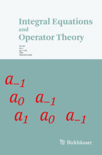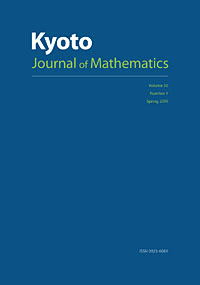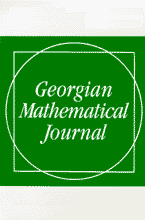
INTEGRAL EQUATIONS AND OPERATOR THEORY
Scope & Guideline
Innovative insights into algebra and number theory.
Introduction
Aims and Scopes
- Integral Equations:
Research on various forms of integral equations, including Volterra and Fredholm equations, exploring their solutions, properties, and applications. - Operator Theory:
Study of linear operators on Hilbert and Banach spaces, including their spectral properties, compactness, and applications to functional analysis. - Functional Analysis:
Investigation of function spaces and their properties, particularly in relation to operators, including topics like reproducing kernel Hilbert spaces and Banach spaces. - Quantum Theory and Applications:
Exploration of mathematical frameworks in quantum mechanics, including operator algebras and quantum harmonic analysis. - Mathematical Physics:
Application of integral equations and operator theory to problems in mathematical physics, including quantum mechanics and PDEs. - Numerical Analysis:
Development of computational techniques and numerical methods for solving integral equations and operator-related problems. - Algebraic Structures and Operator Algebras:
Study of various algebraic structures associated with operators, including C*-algebras and von Neumann algebras.
Trending and Emerging
- Quantum Harmonic Analysis:
An increasing number of publications are exploring connections between operator theory and quantum harmonic analysis, reflecting the growing interest in quantum methods and their mathematical foundations. - Noncommutative Geometry and Operator Algebras:
There is a trend towards research in noncommutative geometry and its applications within operator algebras, indicating a shift towards more abstract and interdisciplinary approaches. - Advanced Spectral Theory:
A noticeable increase in studies related to spectral properties of operators, particularly in the context of infinite-dimensional spaces and their applications. - Optimization and Functional Spaces:
Emerging research focuses on optimization problems related to integral operators and functional spaces, reflecting broader applications in various mathematical and practical contexts. - Connections with Machine Learning and Data Science:
New themes are appearing that connect integral equations and operator theory with machine learning, indicating a modern application of these mathematical concepts in technology and data analysis.
Declining or Waning
- Applications of Integral Equations to Classical Physics:
There has been a noticeable decrease in papers specifically addressing classical physics applications of integral equations, as newer research trends lean towards quantum and modern physics applications. - Basic Theory of Classical Operator Theory:
The foundational aspects of operator theory, which were previously emphasized, are becoming less frequent as the focus shifts towards more advanced and specialized topics. - Elementary Numerical Methods:
Research focused on basic numerical methods for solving integral equations has declined, likely due to the development of more sophisticated techniques and computational methods.
Similar Journals

POSITIVITY
Exploring New Dimensions in Mathematical ResearchPOSITIVITY is a distinguished journal published by Springer, focusing on cutting-edge research in the realms of Mathematics, Analysis, and Theoretical Computer Science. Since its inception in 1997, the journal has fostered intellectual rigor and innovation, catering to a diverse audience of researchers, professionals, and students alike. With an esteemed Q2 ranking in 2023 across multiple categories including General Mathematics, Analysis, and Theoretical Computer Science, POSITIVITY serves as a significant platform for disseminating high-impact findings that advance knowledge in these fields. Though it does not operate under an Open Access model, the journal provides critical insights that contribute to its commendable standing, reflected in its Scopus rankings, which highlight the journal's influence within the academic community. The ongoing publication until 2024 ensures that POSITIVITY remains at the forefront of mathematical discourse, making it an invaluable resource for those dedicated to pushing the boundaries of theoretical and applied mathematics.

Dissertationes Mathematicae
Unlocking the Potential of Mathematical Research.Dissertationes Mathematicae is a prestigious academic journal published by the Polish Academy of Sciences Institute of Mathematics (IMPan), renowned for its contributions to the field of mathematics since its inception. With an impressive Q1 ranking in the miscellaneous mathematics category for 2023 and positioned at Rank #73 out of 399 in General Mathematics according to Scopus, this journal serves as a pivotal platform for disseminating high-quality research and innovative theoretical developments. Spanning from 2000 to 2024, it focuses on a broad range of mathematical disciplines, encouraging interdisciplinary collaboration and advancing mathematical understanding globally. While it currently does not offer open access, the journal is highly regarded in academic circles and continues to attract submissions from respected researchers and institutions. With a commitment to excellence and a notable impact factor, Dissertationes Mathematicae plays a crucial role in the ongoing development of mathematical theories and applications, making it an essential resource for researchers, professionals, and students alike.

Constructive Mathematical Analysis
Fostering Collaboration Through Open Access to Mathematical InsightsConstructive Mathematical Analysis is a distinguished open-access journal dedicated to advancing the field of mathematical analysis, specifically through constructive methods. Published by Tuncer ACAR and affiliated with Selcuk University in Turkey, this journal has been making a significant impact in the academic community since its inception in 2018. With an emerging presence in Scopus, it has earned a Q2 ranking in key categories including Analysis, Applied Mathematics, and Numerical Analysis for 2023, reflecting its commitment to high-quality research contributions. By providing a platform for innovative research and interdisciplinary approaches, "Constructive Mathematical Analysis" aims to facilitate collaboration among researchers, educators, and students in their pursuit of knowledge in mathematical science. With its open-access model, the journal ensures that research findings are accessible to a global audience, fostering an inclusive academic environment.

ACTA SCIENTIARUM MATHEMATICARUM
Exploring Innovative Solutions in Mathematical AnalysisACTA SCIENTIARUM MATHEMATICARUM, published by SPRINGER BIRKHAUSER in Switzerland, is a distinguished journal focusing on the fields of mathematical analysis and applied mathematics. With an ISSN of 0001-6969 and an E-ISSN of 2064-8316, this journal serves as a critical platform for disseminating high-quality research that bridges theoretical and practical aspects of mathematics. Although currently categorized in the Q3 quartile for both Analysis and Applied Mathematics as of 2023, the journal strives to enhance its impact on the mathematical community by offering a perfect blend of rigorous research and innovative applications. Researchers, professionals, and students can benefit from the journal’s commitment to advancing knowledge in mathematics, despite the absence of open-access options. The mailing address for correspondences is 233 SPRING STREET, 6TH FLOOR, NEW YORK, NY 10013. As mathematics continues to evolve, ACTA SCIENTIARUM MATHEMATICARUM positions itself as a valuable resource for those looking to contribute to and stay informed about the latest developments in this vibrant field.

PUBLICATIONES MATHEMATICAE DEBRECEN
Pioneering Insights in Theoretical and Applied MathematicsPublicationes Mathematicae Debrecen is a renowned international journal published by the University of Debrecen, Institute of Mathematics, situated in Hungary. This journal, with both ISSN 0033-3883 and E-ISSN 2064-2849, has established itself in the field of mathematics since its inception, with coverage extending from 1997 to 2024. Recognized for its rigorous academic standards, it currently holds a Q3 ranking in the mathematics (miscellaneous) category for 2023 and ranks at the 42nd percentile among general mathematics journals in Scopus. Publicationes Mathematicae Debrecen aims to disseminate high-quality research across various areas of mathematics, contributing to the advancement of knowledge and practice in this dynamic field. Although it is not an open-access journal, its readers can access a wealth of scholarly work that addresses both theoretical and applied mathematical issues, making it an invaluable resource for researchers, professionals, and students alike.

Annals of Functional Analysis
Advancing the Frontiers of Functional AnalysisAnnals of Functional Analysis is a distinguished international peer-reviewed journal published by SPRINGER BASEL AG that focuses on the interdisciplinary study of functional analysis, encompassing areas such as algebra and number theory, analysis, and control and optimization. With its ISSN 2639-7390 and E-ISSN 2008-8752, the journal is recognized for its significant contributions to research, currently holding a Q2 ranking in its category as of 2023. Spanning from 2010 to 2024, the journal aims to foster innovation and facilitate collaboration among researchers, professionals, and students by offering open access to high-quality articles and studies that push the boundaries of functional analysis. Based in Iran, Annals of Functional Analysis stands out as an essential platform for advancing the knowledge and application of functional analysis in both theoretical and practical domains, making it an invaluable resource for those dedicated to the field.

Kyoto Journal of Mathematics
Unleashing potential through cutting-edge mathematical research.Kyoto Journal of Mathematics is a premier academic publication dedicated to advancing the field of mathematics, published by DUKE UNIVERSITY PRESS. Established in 1996, this journal serves as a vital platform for sharing innovative research and breakthrough studies across various mathematical disciplines. The journal has consistently maintained a prestigious Q1 ranking in the category of Mathematics (miscellaneous) as of 2023, reflecting its significant impact and contribution to the mathematical community. With its Open Access policy, the Kyoto Journal of Mathematics ensures that groundbreaking research is easily accessible to a global audience, fostering collaboration and knowledge dissemination among researchers, professionals, and students alike. The journal's commitment to excellence and relevance in mathematical research is underscored by its extensive archive of published works and its continuous engagement with contemporary mathematical challenges. This makes the journal an essential resource for anyone seeking to stay abreast of current trends and advancements in the field.

Georgian Mathematical Journal
Advancing mathematical frontiers with rigorous research.Georgian Mathematical Journal, published by Walter de Gruyter GmbH, is a prestigious academic journal dedicated to the field of mathematics, particularly in its multifaceted applications and theoretical explorations. With an ISSN of 1072-947X and an E-ISSN of 1572-9176, this journal is indexed within notable databases and holds a strong position as evidenced by its Q2 ranking in the Mathematics (miscellaneous) category as of 2023 and a ranking of #140 out of 399 in the general mathematics Scopus category, placing it in the 65th percentile for research visibility. Since its inception in 1994, the journal has continued to evolve, aiming to foster innovative research and scholarly communication among mathematicians worldwide. Although it does not offer Open Access, the journal’s commitment to quality and rigor ensures that published works are of high relevance, appealing to researchers, educators, and students who are dedicated to advancing mathematical knowledge across diverse domains.

ANNALI DI MATEMATICA PURA ED APPLICATA
Pioneering Insights in Pure and Applied MathematicsANNALI DI MATEMATICA PURA ED APPLICATA is a prestigious journal published by Springer Heidelberg, focusing on the field of Applied Mathematics. With a rich history dating back to its initial publication stages from 1858, this journal continues to serve as a vital platform for researchers and professionals seeking to disseminate high-quality, peer-reviewed research. The journal's strong reputation is reflected in its Q1 ranking in Applied Mathematics and its Scopus rank of #335 out of 635, placing it in the 47th percentile, showcasing its impact in the field. Although it is not an open-access journal, it provides exclusive insights and advancements in mathematical applications, allowing academics to explore innovative methodologies and theoretical developments. The combination of its long-standing tradition and contemporary relevance makes ANNALI DI MATEMATICA PURA ED APPLICATA an essential resource for scholars and students looking to deepen their understanding of mathematics and its practical applications.

Forum of Mathematics Sigma
Advancing mathematical frontiers for a global audience.Forum of Mathematics Sigma is a premier open access journal published by Cambridge University Press that has been at the forefront of mathematical research since its inception in 2013. With a strong emphasis on advancing the fields of mathematics, the journal consistently achieves Q1 rankings across multiple categories, including Algebra and Number Theory, Analysis, and Computational Mathematics. This distinction highlights its impact and relevance within the scholarly community. The journal prides itself on providing a platform for innovative research, fostering collaboration among researchers and practitioners across various mathematical disciplines. Open access publication ensures that cutting-edge findings are widely available to readers globally, enhancing the dissemination of knowledge. With an address in the heart of Cambridge, England, Forum of Mathematics Sigma is dedicated to promoting high-quality research and making significant contributions to the development of mathematics.